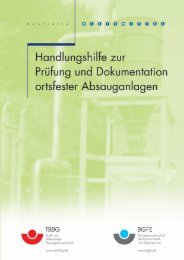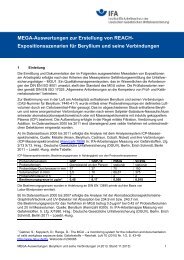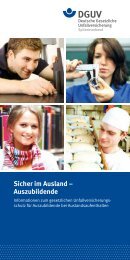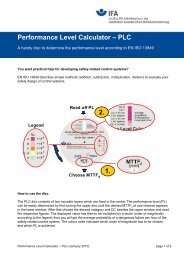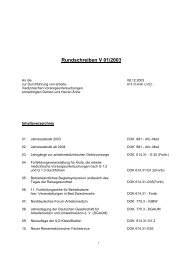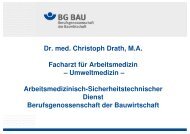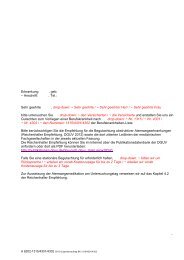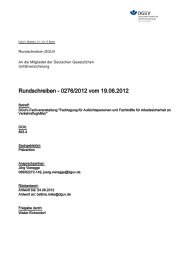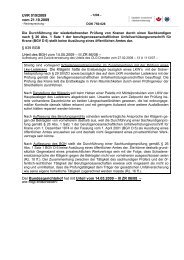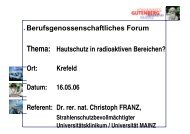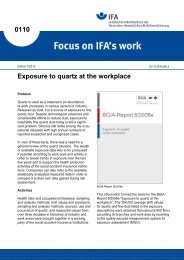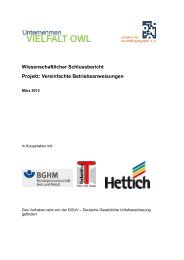Effectiveness of measures to prevent needlestick injuries among ...
Effectiveness of measures to prevent needlestick injuries among ...
Effectiveness of measures to prevent needlestick injuries among ...
You also want an ePaper? Increase the reach of your titles
YUMPU automatically turns print PDFs into web optimized ePapers that Google loves.
3 Descriptive epidemiology <strong>of</strong> NSI<br />
involved in NSI might be altered if calculations accounted for frequency <strong>of</strong> use each<br />
type <strong>of</strong> equipment.<br />
NSI are most likely <strong>to</strong> occur during use, with the second highest rate associated with<br />
recapping used needles and disposing <strong>of</strong> used sharps (Table 7, see page 93). These<br />
activities are all amenable <strong>to</strong> engineering controls and/or safety training aimed at<br />
reducing the NSI rate. Of note, the US Occupational Safety and Health Administration<br />
(OSHA) disallowed recapping beginning in 1992, with 29 CFR 1910.1030.<br />
Bearing in mind that surveillance data are only available for hospitals, Table 8 (see<br />
page 94) shows that NSI were most likely <strong>to</strong> occur in patient rooms and operating<br />
rooms, locations where sharps were most likely <strong>to</strong> be used. Not included in these data<br />
were estimates for HCW employed in outpatient settings or nursing homes; home<br />
health care providers; emergency first responders; dentists and dental technicians;<br />
or others employed in non-hospital settings.<br />
Limited NSI surveillance or survey data for individual or small groups <strong>of</strong> hospitals<br />
were available for several other European countries (Denmark, Greece, Sweden, and<br />
Switzerland) but are not shown in the tables because they do not represent national<br />
data. The patterns <strong>of</strong> NSI occurrence, including the relative distribution by occupatio-<br />
nal group, location, type <strong>of</strong> equipment and activity during NSI, were generally similar<br />
<strong>to</strong> the national patterns noted in the surveillance data described in tables 4 <strong>to</strong> 8:<br />
Nurses and physicians uniformly reported the most <strong>injuries</strong>, and the nurses’ generally<br />
exceeded physicians’ reports by at least a fac<strong>to</strong>r <strong>of</strong> two [25; 26; 28; 30]. NSI tended<br />
<strong>to</strong> occur most frequently in patient rooms [26; 28; 30], and needles were the most<br />
frequently involved type <strong>of</strong> equipment [25; 26; 28; 30]. The high rate <strong>of</strong> NSI due <strong>to</strong><br />
recapping or improper disposal <strong>of</strong> used needles suggests that a large proportion <strong>of</strong><br />
reported events were avoidable [25; 26; 28; 30].<br />
Additional data were available based on a survey <strong>of</strong> hospital-employed physicians in<br />
Denmark by Nelsing et al. [31]. About 30 % <strong>of</strong> respondents practiced surgical special-<br />
ties, and this subgroup reported higher rates <strong>of</strong> NSI compared <strong>to</strong> their colleagues in<br />
non-surgical specialties: There were 6 <strong>to</strong> 8 NSI per person-year at risk <strong>among</strong> general<br />
surgeons, orthopedic surgeons and neurosurgeons, versus 3.1 and 1.3 NSI per per-<br />
son-year <strong>among</strong> internists and anesthesiologists, respectively. Overall, the surgical<br />
Report „Needlestick <strong>injuries</strong>“ 26



